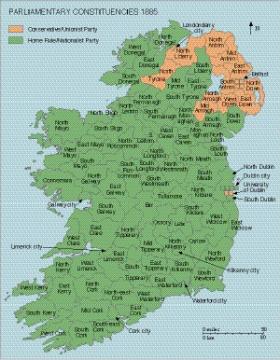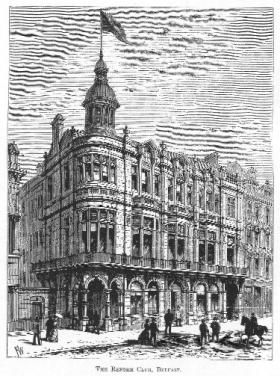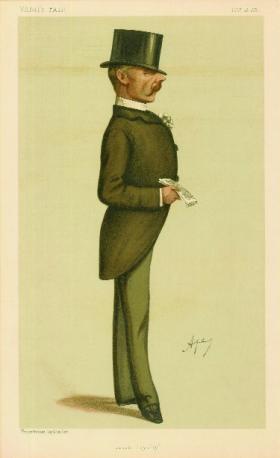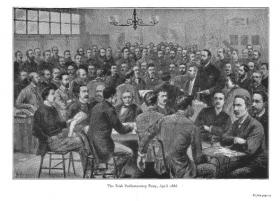The 1885 and 1886 general elections in Ireland
Published in 18th–19th - Century History, Features, Issue 6 (Nov/Dec 2005), Volume 13 The general elections of 1885–6 can be regarded fairly as a milestone in modern Irish political history. In part their importance lies in the fact that they were fought under a new, much-widened franchise and that they witnessed the appearance of modern types of party organisation. In greater part, however, their significance arises because the forces of nationalism and unionism dominated the political scene for the first time in an unequivocal manner: at the same time strong links were established between political and religious divisions.
The general elections of 1885–6 can be regarded fairly as a milestone in modern Irish political history. In part their importance lies in the fact that they were fought under a new, much-widened franchise and that they witnessed the appearance of modern types of party organisation. In greater part, however, their significance arises because the forces of nationalism and unionism dominated the political scene for the first time in an unequivocal manner: at the same time strong links were established between political and religious divisions.
Conflict over nationalism was not new to elections in Ireland, but in the past there had been a wide range of political opinion and swings in popular support often occurred. In the 1850s and 1860s the political scene had been dominated by the Liberal and Conservative parties that accepted the United Kingdom framework. A majority of Irish MPs elected in 1874 supported home rule, but most Home Rulers elected in 1880 were more concerned with the land question than with home rule. Religious cleavages, of course, had impacted on earlier elections, but in the past the influence of religious division on politics was rarely clear-cut, with Conservatives, Liberals and Home Rulers all enjoying some cross-denominational support on particular occasions.
New electoral rules
Prior to 1885, elections in Ireland had been restricted to those occupiers of property valued at £12 and over in the counties or at £4 and over in the parliamentary boroughs. The Franchise Act of 1884, however, extended the vote to all adult male householders who had paid their rates and were registered. Women continued to be disfranchised but at least most households in the country now had the vote. This resulted in a massive, over threefold, increase in the number of Irish electors, from 225,999 in 1884 to 737,965 in 1885. Rules were also introduced to limit the amount of money that a candidate or party could spend in the election campaign, which meant that in future constituency organisations would have to be run largely on a voluntary basis.
Such changes presented all the parties with the problem of dealing with an electorate that had not only grown in size but had widened its social character from a mainly well-off farmer base to include small farmers and labourers. In addition, throughout the country there was a heightened sense of political consciousness, aroused originally over the land question. Agrarian protest had undermined the landlords, who had traditionally played a key role in Irish politics. After the 1881 Tyrone by-election one observer commented: ‘The fact is the Protestants as well as the Roman Catholics do not want an Orangeman or even a Fenian if he is a gentleman or a landlord’. By 1885, thanks to several land acts, landlord–tenant relations were no longer a pressing issue, which meant that other divisions, such as between farmers and labourers, and between Protestant and Catholic, assumed new importance for the parties, as did interest groups and internal conflicts. The parties responded in different ways to these new challenges.
The Home Rule Party

The Reform Club, Royal Avenue, Belfast, headquarters of the Ulster Liberals. (Industries of the North, 1891)
After the 1880 general election Charles Stewart Parnell had taken over the leadership of the Home Rule Party, but it remained a loosely organised body with ad hoc organisational structures in the constituencies and little discipline among members in parliament. In early 1885 it was reckoned that Parnell could count on the whole-hearted support of only some 20–30 MPs of his Home Rule group, and he had to deal with both radical nationalist elements and agrarian activists, in particular Michael Davitt. Parnell, however, was also head of the National League, which had been set up to harness agrarian and nationalist protest after the suppression of the Land League. During 1885 the home rule movement underwent fundamental change and growth under Parnell and the National League.
In common parlance the term ‘Home Ruler’ gave way to ‘Nationalist’. The National League provided an effective organisation through its local branches, which expanded rapidly in 1885 and were based in every Irish county. Timothy Harrington was the main individual responsible for organising these National League branches. County conventions selected parliamentary candidates, under the supervision of representatives from the organising committee of the league, which was controlled by Parnell. A pledge was introduced to bind the MPs together into a tightly disciplined party.
Thus, as Conor Cruise O’Brien has remarked, the home rule movement was transformed into a ‘well-knit political party of a modern type—effectively monopolising the political expression of national sentiment’. The National League embraced farmers and labourers and so helped to mitigate the effects of social division. Effective steps were taken to marginalise Davitt and any others who challenged the party leadership. For example, a number of National League branches loyal to Davitt were closed down, and a strong effort was made to prevent any of his supporters gaining a nomination.
Vital for this socially cohesive, countrywide organisation was the forging of a ‘very effective, if informal, clerical nationalist alliance’, as Emmet Larkin has called it. Acceptance of Catholic claims in educational matters in mid-1885 won the party leadership the public approval of the Catholic hierarchy, which had hitherto been suspicious of Parnell and his plans. Catholic clergy were now given the right to attend Nationalist conventions to select parliamentary candidates. It has been estimated that these conventions for all 32 Irish counties had an approximate average of 150 laymen and 50 priests. The clergy played a prominent part not only at these conventions but also in organising National League branches.
In the months preceding the election, candidates were selected for every constituency, except those Ulster divisions with a Protestant majority. The one exception was Mid-Armagh, where a Nationalist was put forward at the last minute to undermine the chances of a Liberal standing, as part of a private agreement with the local Conservative organiser not to run a candidate in South Armagh, where the Nationalist leadership feared a split nationalist vote. In the end, however, so successful was the party in capturing the nationalist electorate that only in two Irish divisions did an independent nationalist stand at the general election. In early October 1885 Parnell declared that the party platform would consist of a single plank, ‘the plank of legislative independence’.
Southern loyalists
In response to this nationalist reorganisation, the Irish Loyal and Patriotic Union (ILPU) was formed in Dublin in May 1885 by a number of southern businessmen, landowners and academics. It sought to unite Liberals and Conservatives in the three southern provinces on a common platform of maintenance of the union. The ILPU also published pamphlets and leaflets that were distributed widely. The organisation was successful in preventing rivalry between Liberals and Conservatives, and in a number of cases candidates came forward in the general election simply as ‘loyalists’. A total of 54 of the southern seats were contested by anti-home rule candidates.
Ulster Liberals
In Ulster, however, appeals for unity between supporters of the union went unheeded, and the general election of 1885 involved not only contests between Nationalists and supporters of the union but also rivalry between Liberals and Conservatives. On the eve of the elections the Ulster Liberals, whose support lay chiefly with the tenant farmers and included mainly Presbyterians and Catholics, held nine seats. With an impressive headquarters at the recently built Reform Club in Belfast, they sought to develop new local divisional associations. This reorganisation had only limited success, particularly in relation to the new labouring voters, thanks in part to the identification of the Liberals with the farmers’ cause. Liberal candidates declared their support for the union and also called for further land reform.
Ulster Conservatives

Col. E.J. Saunderson—one of the leading figures in forging a single pro-union Irish party in early 1886. (Vanity Fair)
Before the 1885 general election the Conservatives held seventeen seats in Ulster. While they were widely regarded as the former landlord party, they had developed a number of county and borough Conservative associations, although these bodies had a limited popular appeal. During 1885, however, under the energetic efforts of E.S. Finnigan, a full-time party organiser based in Belfast, the Conservatives extensively reorganised. Finnigan helped to set up many divisional associations with strong local participation, especially in the key areas of Belfast and counties Down and Antrim. Conventions of these associations then chose candidates for the general election. In their speeches and addresses the Conservatives emphasised their support for the union.
A vital aspect of this reorganisation was the involvement of the Orange Order, which experienced growth in this period. Local lodges were given special positions in many of the new organisations. For example, speaking in Ballynahinch, Co. Down, on 7 May 1885, Finnigan described proposals to set up a broadly based local association: ‘the Orange association would have a well-defined position. The district master and district officers . . . would be appointed upon . . . each committee’. At this stage the Order was a minority movement among Protestants, but it embraced many of the recently enfranchised labourers and was therefore an important means of integrating industrial and agricultural workers into the Conservative Party.
Such arrangements went smoothly in counties Antrim and Down but ran into trouble in Belfast and counties Armagh and Londonderry, where Orange labourers felt that they were being given no influence in the new Conservative machine: in the latter areas they rebelled against local Conservative organisers and either forced them to accept candidates agreeable to them or, as in the case of two of the four Belfast seats, ran independent candidates of their own. In North Armagh the divisional Conservative association was forced to replace its preferred candidate of the attorney-general, John Monroe, with the local Orangemen’s choice of Col. E.J. Saunderson.
Wheeler-dealing and cross-voting
Because the Nationalists only put forward candidates in Ulster constituencies with a Catholic majority, this left an uncommitted nationalist vote which now became very important in the struggle between Liberals and Conservatives. In late October 1885 Mrs Katherine O’Shea wrote confidentially to the Liberal whip at Westminster, Lord Richard Grosvenor, conveying a promise from Parnell that he would secure the Catholic vote in three Ulster divisions for the Liberals if they adopted her husband, Capt. W.H. O’Shea, as a Liberal candidate in Mid-Armagh. O’Shea visited the constituency but locals refused to accept him (subsequently, in early 1886, Parnell persuaded the Nationalists of Galway to take O’Shea as their candidate in a by-election).
In the final run-up to the elections private deals were made between local Conservative and Nationalist organisers in several divisions in counties Armagh and Down to prevent any splits in their own ranks and to undermine the Liberals. On the eve of the general election Parnell made a public statement that declared that if Liberals voted for Nationalists in several key Ulster seats, such as Derry city, then Nationalists should back Liberals in certain divisions: if the Liberals failed to do so then Nationalists should vote against them.
Contested elections were held on different days over a period of two weeks starting on 26 November 1885. When it soon became clear that Liberals had not supported Nationalists in the specified seats, a number of Nationalist spokesmen, including John Dillon, announced that the Catholic vote in remaining constituencies with no Nationalist candidates should be given to the Conservatives.
1885 general election outcome
The outcome of the general election was a startling one compared to the results of 1880, when 63 Home Rulers, 25 Conservatives and fifteen Liberals were returned. The Nationalist Party won 85 seats throughout Ireland, plus a seat in Liverpool. In Ulster the party held seventeen of the 33 constituencies. Apart from two Dublin University seats held by Conservatives, pro-union candidates won no seats outside Ulster. In Ulster the Conservative Party took sixteen seats while the Liberals failed to win any, which left the former as the principle spokesmen for unionism. (These Conservative figures include two successful independent candidates in Belfast who were subsequently adopted by official Conservative associations.)
This outcome revealed a high degree of religious polarisation in politics. Protestant Nationalists such as Parnell, or Catholic pro-union supporters such as Daniel O’Connell, grandson of the Liberator and a loyalist candidate in South Kerry, were exceptions. Out of 85 Nationalists, 80 were Catholic. Apart from three Presbyterians and one

Print of Charles Stewart Parnell (standing) and his MPs in April 1886. (T.P. O’Connor, Memoirs of an Old Parliamentarian, vol. I, 1929)
Methodist, the rest of the eighteen Conservatives were members of the Church of Ireland; most of the unsuccessful Liberal candidates in Ulster had been Presbyterians. Contrary to earlier trends against landlords, eight of those Conservatives came from a landed background and owed their election in part to the new labourers’ vote, which went to them rather than to the pro-farmer Liberals.
An analysis of the voting also reveals that the electorate had divided sharply along denominational lines throughout the country. It is clear that most Catholics who voted backed the Nationalist Party, except in some northern constituencies where there were no Nationalist candidates and where Catholics voted Conservative for tactical reasons. In perhaps as many as six divisions in Ulster last-minute Catholic support for the Conservative against the Liberal proved significant. Some Catholics continued to support the Liberal cause in north-east Ulster. In a few southern constituencies small numbers of Catholics may have voted for pro-union candidates.
It is also evident that nearly all Protestants who voted supported pro-union candidates. Although Protestants were around ten per cent of the population outside Ulster, they were too widely dispersed to win any seats. In South Londonderry alone is there evidence of a significant number of Protestants voting for a Nationalist candidate. This was partly because of the reputation of the Nationalist candidate, T.M. Healy, on the land question and partly because of efforts to give the National League organisation in the county a non-sectarian image. Within nine months a second general would be called which would serve to copper-fasten the outcome of the 1885 general election.
Events 1885–6
The Irish Nationalist parliamentary party was now in a very strong position at Westminster. All 86 members were pledge-bound to support the party under the leadership of Parnell. Nationalists held the balance of seats between the two major parties in the House of Commons. The Ulster Conservatives lacked such central control, but early in 1886 they decided to form a broad-based group, including supporters from other constituencies, to work together as a pro-union Irish party: the two leading figures were William Johnston and Col. E.J. Saunderson.
Early in 1886 Gladstone announced his support for home rule, and in April the first home rule bill was introduced but defeated, which resulted in another general election in mid-1886. Gladstone’s action caused a split among the Liberals. In Ulster the vast majority of Liberals became ‘Liberal Unionists’ and joined with the Conservatives, now usually known as ‘Unionists’, in a common pro-union front. A small group of pro-Gladstone supporters fought the elections as Gladstonian Liberals. A new organisation called the Irish Protestant Home Rule Association (IPHRA), which aimed to promote home rule among Protestants, also appeared. The single issue at the general election of 1886 was the question of the union.
1886 general election
At the new general election only 33 constituencies in Ireland were contested, compared with 79 in 1885; outside Ulster a mere seven divisions out of 68 saw a poll. In the three southern provinces a Nationalist candidate stood for each seat, making a total of 70 Nationalist candidates, of whom 62 were returned unopposed; six Conservatives and two Liberal Unionists also stood.
Most Ulster divisions were contested. In seventeen of these contests, Unionists (former Conservatives) faced Nationalists (including six members of the IPHRA), while in five Liberal Unionists fought Nationalists. In five divisions Gladstonian Liberals opposed Unionists. The bulk of former Liberals in the main Unionist-dominated constituencies in the north-east played little part in the election, leaving the Unionist political organisations to be effectively controlled by the Conservative victors of 1885.
The outcome of the general election was that, overall, Nationalists won 84 seats, plus a seat in Liverpool. Outside Ulster they controlled the entire Irish representation, except for the two Dublin University seats. In Ulster Unionists won fifteen seats and Liberal Unionists two, a telling picture of the comparative strength of the former Conservatives and Liberals in the new Unionist movement. The Liberal Unionists would survive as a minor grouping within the unionist family until the full incorporation of the Liberal Unionists into the Unionist Party in 1911.
Viewed broadly, it is evident again that most Catholic voters supported Nationalist candidates and most Protestant voters backed Unionists or Liberal Unionists. There was some, but not significant, variation to this general picture. Liberal Unionist candidates attracted some Catholic votes, which made a small but important difference in a number of divisions. Some Protestants, perhaps around 3,000, voted for Gladstonian Liberals or Nationalists (including members of the IPHRA) in Ulster.
Consequences
The political developments of 1885–6 had important consequences for the evolution of both Nationalism and Unionism in Ireland. These two years were a time of great political mobilisation and change. The question of the union moved to centre stage. Events were influenced both by changes in the franchise and electoral law and by the emergence of modern types of party organisation, local and central. The response of party leaders and organisations not only affected party fortunes but also influenced greatly the whole nature of politics to develop at this time. The new party structures had an influential bearing on the type of politics and society to emerge.
The decision by both the Nationalist and Unionist party leaderships to link their political movements to important sectional groups, such as the Catholic clergy and the Orange Order, was important to meet the challenges of 1885–6 and to win the elections in a convincing manner. At the same time this response meant that the two victorious parties had decisively strengthened the links between their respective movements and denominational divisions in society.
The new nationalist movement that emerged had support from throughout the island of Ireland, but in practice it represented only the Catholic community. There had been links in the past between Irish nationalism and Catholicism, but the events of the mid-1880s established such links in a very public and thorough way. Ironically, it was a Protestant leader of the Nationalist Party, Parnell, who was responsible for the ‘alliance’ of 1884–5 between nationalism and the Catholic Church that played a vital part in the electoral success of his party. Undoubtedly, as Emmet Larkin has argued, this link had democratic benefits in that it prevented the emergence of an all-powerful central party, but it also helped to strengthen the denominational character of nationalism.
The new Unionist movement was concerned with defending the union, but because of the events of 1885–6 it represented only Protestants and its main base was in Ulster. Outside of Ulster, unionism remained an influential but politically weak minority. Furthermore, this Ulster unionism was linked strongly to the former Conservatives, with their strong Orange links, rather than to the former Liberals, who had made some effort to encourage cross-denominational support for their unionist stance. Ironically, the tactical support given by Nationalists to Conservatives in 1885 played a vital role in the shift of power in the pro-union movement to Conservative and Orange elements. While the link between the Orange lodges and the new Unionist associations did introduce a populist, democratic element into unionist politics, it also served to reinforce the denominational nature of unionism.
These general elections were a milestone in the evolution of modern nationalist and unionist movements in Ireland. Party leaders, organisers and supporters created a new order of politics in which religious and nationalist/unionist divisions were firmly related. The fact that these developments occurred at the same time as the extension of the franchise to most households and the emergence of modern party organisations helps to explain why the outcome of these particular elections proved to have such lasting importance. Later events would influence the eventual settlement in Ireland in 1921–2, but the basic shape of the conflict, with its closely linked political and religious features, was established in this formative period.
Brian Walker is Professor in the School of Politics, International Relations and Philosophy at Queen’s University, Belfast.
Further reading:
R.V. Comerford, ‘The Parnell era, 1883–91’, in W.E. Vaughan (ed.), A New History of Ireland. Vol. VI, Ireland under the union, II, 1870–1921 (Oxford, 1996).
C.C. O’Brien, Parnell and his party, 1880–90 (Oxford, 1957).
B.M. Walker, Parliamentary election results in Ireland, 1801–1922 (Dublin, 1978).
B.M. Walker, ‘The 1885 and 1886 general elections: a milestone in Irish history’, in Dancing to history’s tune (Belfast, 1996).
















